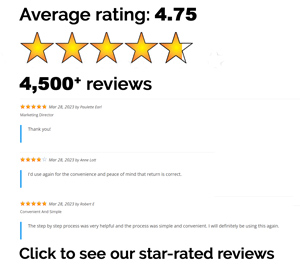The information in this article is up to date for tax year 2023 (returns filed in 2024).
For most people, the highlight of doing their taxes is getting a big fat refund. This is money that can be used to pay off debt, boost your savings or treat yourself to something nice. According to the IRS, the average refund in 2023 was $3,054. If you’re trying to figure out how to get the biggest tax refund, check out our tax tips.
Adjust your tax withholding
When you first started your job, you completed a W-4 which told your boss how much taxes to withhold from each check. Receiving a tax refund simply means you withheld and paid too much to the IRS, and now the government is giving you back your money.
If you want to get a bigger refund, adjust your withholding by submitting a new W-4 to your employer. In other words, you’ll want to claim less allowances so more taxes will be withheld from your pay. Keep in mind that although you’ll get a larger refund at tax time, your paycheck will be smaller throughout the year.
Increase your retirement contributions
A smart way to boost your refund is to save for retirement. Since traditional IRAs and 401Ks are funded with pre-tax dollars, any contributions you make will lower your taxable income dollar for dollar. As long as you don’t exceed the contribution limit, you can sit back and watch the tax savings pile up. For 2023, the maximum you can contribute to a 401K is $22,500 ($30,000 if you’re aged 50 or older). Meanwhile, IRAs have a contribution limit of $6,500 ($7,500 if you’re aged 50 or older).
Don’t take the standard deduction if you can itemize
Don’t automatically assume that taking the standard deduction is the right choice for you. If your deductible expenses exceed the standard deduction for your filing status, itemizing may be worth the effort.
Standard Deduction Amounts for Tax Year 2023
| Filing Status | Standard Deduction |
| Single; Married Filing Separately | $13,850 |
| Married Filing Jointly & Surviving Spouses | $27,700 |
| Head of Household | $20,800 |
Here’s a list of qualified expenses:
- Home mortgage interest
- State and local income taxes or sales taxes
- Real estate and personal property taxes
- Charitable contributions
- Unreimbursed medical and dental expenses
When you do your taxes with ezTaxReturn.com, we automatically compare your standard and itemized deductions so you can choose the option that saves you the most money.
Contribute to an HSA
If you have a high-deductible health plan (HDHP), you may be eligible for a Health Savings Account (HSA). An HSA is a savings account that lets you set aside pre-tax dollars for medical expenses not covered by insurance.
Generally, your HDHP minimum deductible must be $1,500 for self-only or $3,000 for family coverage to qualify. Also, your maximum out-of-pocket expenses cannot exceed $7,500 for individuals and $15,000 for families. The major draw of an HSA is that your contributions reduce your taxable income. For 2023, the maximum you can contribute to an HSA is $3,850 for individuals and $7,750 for families. If you’re 55 and older, you’re also allowed to make catch-up contributions up to $1,000.
Rethink your filing status
Choosing the right tax filing status can be a huge money saver. Normally, people who aren’t married select single as their filing status without much thought. However, if you’re unmarried and pay more than half of the household expenses for you and a qualifying person, filing head of household may be a better fit.
The main reason to make the switch is because the standard deduction is higher. The standard deduction is $13,850 for single filers and $20,800 for head of household. That’s $6,950 you’ve instantly saved without any effort.
If you do your taxes at ezTaxReturn.com, you can prepare multiple returns free, each with a different status, to see which gives you the biggest tax refund before you file.
Claim every tax break you deserve to get the biggest tax refund
Every year one in five eligible workers misses out on the Earned Income Tax Credit (EITC) due to lack of awareness.
The EITC credit ranges from:
- Up to $7,430 with three or more qualifying children
- Up to $6,604 with two qualifying children
- Up to $3,995 with one qualifying child
- Up to $600 with no qualifying children
That’s up to $7,430 you’re letting slip through your fingers. (Check your EITC eligibility).
The key to minimizing your tax liability is to take advantage of every credit and deduction you’re eligible for. An easy way to ensure you don’t miss out is to use tax software like ezTaxReturn.com to prepare your return. Their simple question and answer format makes it easy to maximize your credits and deductions so you get the biggest possible refund, guaranteed.
The articles and content published on this blog are provided for informational purposes only. The information presented is not intended to be, and should not be taken as, legal, financial, or professional advice. Readers are advised to seek appropriate professional guidance and conduct their own due diligence before making any decisions based on the information provided.




